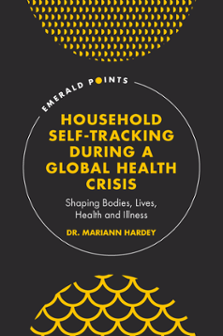
Afterword
Household Self-Tracking during a Global Health Crisis
ISBN: 978-1-80043-915-3, eISBN: 978-1-80043-914-6
Publication date: 21 February 2022
Citation
Hardey, M. (2022), "Afterword", Household Self-Tracking during a Global Health Crisis, Emerald Publishing Limited, Leeds, pp. 113-114. https://doi.org/10.1108/978-1-80043-914-620221010
Publisher
:Emerald Publishing Limited
Copyright © 2022 Mariann Hardey. Published under exclusive licence by Emerald Publishing Limited
I began my journey with health tracking at a young age. It has sustained my desire to understand and manage chronic health conditions, as well as a sense of deepening my knowledge of health data and what individuals could do with it, if we all had access to it.
In reading this book, I hope that you have a sense of the different aspects of health data and the combination of tracking behaviour. There is so much to untangle in household tracking, from the commercial organisations seeking to profit from health data, to the policymakers closely reviewing and analysing social uses of health data, to the education required to fully understand self-tracking data legacy in our lives.
Writing the book, in a state of global uncertainty around health when there were long periods for which we were confined to being at home, was terrifying, empowering, overwhelming, informative and confusing all at the same time. Talking about household tracking with others immediately raised concerns about when not to track, especially when governments and global health policies are involved and trying to persuade us to adopt health tracking, if not impose it on us.
Despite growing policy initiatives, health tracking is a personal choice. There are very active communities focused on user data and privacy rights, patient record access and open data that can help raise awareness of the different ways people can understand health data. In writing this book, the tension was clear between health data being used as a commercial asset for profit by some organisations, the role of public health providers such as the NHS in the United Kingdom, investment by government agencies and the level of control of users themselves. Households, or ‘bubbles’ as they were determined in the pandemic, provided an appealing and comforting narrative in the context of growing health uncertainties such as those associated with vaccination risk, the need to shield and protect extremely clinically vulnerable groups, and increased apprehension about policy-led decisions. The same bubble helped me in feeling a sense of protection: that I could provide for my family myself.
What is striking, having reflected back over the book, is how each of the households believed and invested so passionately in personal health responsibility. Growing fears about the pandemic translated into increased household tracking practices across generations, people and even animals. I find myself thinking about how positive associations with tracking may obscure the recognition of emerging health anxieties and intolerance towards people who behaved differently from their household and from whom other household members sought to differentiate themselves. Instead of following only the most frequent trackers, I turned to households with mixed tracking use to better understand health as a form of responsibility and, at times, difference, which defined attitudes and behaviours towards health at various stages of life. The health tracking narratives reveal that households serve as a focal point of meaning for perceptions of responsibility and expected behaviour. This may seem obvious, but research into household health dynamics has led to the expansion of reciprocal care, with adjustments in how commitments to the needs of dependent members were met within the home. Another manifestation of what is viewed as ‘risky’ health behaviour is being modified within households, while also connecting outwards to new social movements and various forms of single-issue and identity politics (e.g. ‘fitspro’, food sustainability, anti-racism and gender politics), with health tracking helping to create new identities and challenge normative health images.
My sense of self is being remade because of my health tracking. I believe that a future of household tracking that allows access to and understanding of personal data is now an essential part of people's social identities and the prevention of life-threatening diseases. At the beginning of the book, I argued that how we construe health and how society copes with ill health are central to the beliefs and practices, and the commercialisation, of self-tracking. For my part, being immersed in a home environment of household tracking has begun to untangle some of the complexity surrounding the treatment of those who are temporarily or permanently dependent on others for care. Care is a crucial domain that reveals the tensions between ill health and dominant societal values and roles starkly – especially for women. The reader will have realised that I am not happy with the increasing tendency to encourage profit from commercial health products. Readers will make their own judgements here.
- Prelims
- Introduction: Self-Tracking Construction of Health
- 1 Description of the Household Tracking Study
- 2 Visualising Tracking and Responding to Digital Bodies
- 3 Tracking Entangled with Health Expertise
- 4 Caring and Tracking
- 5 Consuming with Tracking: Food Habits and Eating
- 6 Intergenerational Narratives with Tracking
- Conclusion: Transformations with Self-Tracking
- Epilogue: Self-Tracking with Pets
- Afterword
- Related Work and Resources
- References
- Index